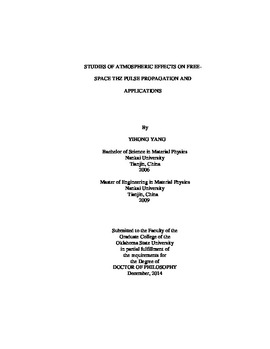| dc.contributor.advisor | Grischkowsky, Daniel R. | |
| dc.contributor.author | Yang, Yihong | |
| dc.date.accessioned | 2016-01-20T15:45:11Z | |
| dc.date.available | 2016-01-20T15:45:11Z | |
| dc.date.issued | 2014-12 | |
| dc.identifier.uri | https://hdl.handle.net/11244/25738 | |
| dc.description.abstract | Within THz frequency range, free-space propagated EM wave and the related applications have attracted a lot of attention, due to promising solutions for new types of remote sensing, wireless communications and security applications. However, the characteristics of free-space THz wave are degraded by several atmospheric conditions, such as water vapor absorption and pulse distortion. | |
| dc.description.abstract | In this thesis, a comprehensive study on atmospheric effects on free-space THz signal and its potential applications by using the state-of-art Long-Path THz-TDS system is presented. Two types of absorptions from the ambient water vapor have been investigated: the resonant absorption which is associated with strong phase shifts and the continuum absorption. The molecular response theory is used as the lineshape function based on parameters from JPL and HITRAN databases for simulation to water vapor resonant absorption and phase shift. Not only were the THz digital bit observed for potential wireless communications, but the refractivity of water vapor was also obtained by line-by-line summation. | |
| dc.description.abstract | A series of accurate experiments of water vapor continuum absorption have been carried out by using the 170 m Long-Path THz-TDS system. With precise experimental results and MRT simulation, the parameters for general model of water vapor continuum absorption have been successfully obtained within several THz transparent windows. As another kind of atmospheric condition, artificial fog fully filled the 137 m long sample chamber, in order to investigate absorption and phase shift of the atmospheric diffusive scattering mediums. | |
| dc.description.abstract | With all the quantitative understanding of the atmospheric effects, a comprehensive atmospheric model for the free-space THz signals has been established, including the humidity, temperature and distance. This model can be used to provide a theoretical verification for all of the free-space THz applications. | |
| dc.description.abstract | To demonstrate another free-space THz application, a series of experiments of THz-TDS remote detection of small molecules vapor have been performed. Samples of CH3CN, D2O and HDO have been successfully detected using 170 m Long-Path THz-TDS system. Moreover, the reaction ratio of the transition from H2O and D2O to HDO has been monitored in time. | |
| dc.format | application/pdf | |
| dc.language | en_US | |
| dc.rights | Copyright is held by the author who has granted the Oklahoma State University Library the non-exclusive right to share this material in its institutional repository. Contact Digital Library Services at lib-dls@okstate.edu or 405-744-9161 for the permission policy on the use, reproduction or distribution of this material. | |
| dc.title | Studies of atmospheric effects on free-space THz pulse propagation and applications | |
| dc.contributor.committeeMember | Zhang, Weili | |
| dc.contributor.committeeMember | West, James C. | |
| dc.contributor.committeeMember | Rosenberger, Albert T. | |
| osu.filename | Yang_okstate_0664D_13648.pdf | |
| osu.accesstype | Open Access | |
| dc.type.genre | Dissertation | |
| dc.type.material | Text | |
| thesis.degree.discipline | Electrical Engineering | |
| thesis.degree.grantor | Oklahoma State University | |
